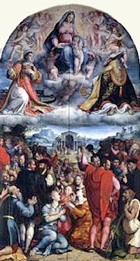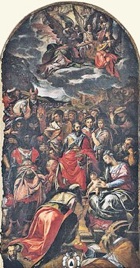Sala Podiani
After climbing the stairs, but before entering the gallery, look into this room on the right, which is reserved for temporary exhibitions. It is named in honour of the bibliophile Prospero Podiani, who donated his collection of some 7,000 books to the Commune in 1582. This collection, which formed the nucleus of the Biblioteca Comunale Augusta, was housed here until 1968.
This room, which formed part of the original nucleus of the palace, was recorded from 1296. It was directly above the main meeting room that the Capitano del Popolo used for meetings of his advisors. The remains of frescoed arms of some of the holders of this office survive on the entrance wall, although nothing remains of the frescoes (1475) that the young Perugino executed here.
The room houses a few altarpieces that are too large to be exhibited in their chronological sequence in the gallery.
Santa Maria del Popolo Altarpiece (1548-9)

Giorgio Vasari, who records this commission, adds that Cristofano Gherardi, il Doceno “painted with his own hands all the upper part, which is indeed most beautiful and worthy of great praise”. There is no documentary evidence of this assertion, but it is supported on stylistic grounds. (The two artists had already worked together at Rocca Paolina).
-
✴In the upper part of the altarpiece, the Madonna is surrounded by angels and seated on a cloud. She holds the standing baby Jesus and is flanked by SS Herculanus and Laurence.
-
✴Below, the citizens of Perugia are assembled in front of a church in a landscape. While this church was probably meant to represent Santa Maria del Popolo, it is actually a direct quotation from a fresco (ca. 1525) of a scene from the life of St Catherine of Siena in Silvestro al Quirinale, Rome, , which is by Polidoro da Caravaggio and Maturino da Firenze.
Adoration of the Magi (1564)

In his “Life” of Benvenuto Garofalo and others, Giorgio Vasari writes that “the Fleming Arrigo, a master of glass windows, has painted in [San Francesco al Prato] an altarpiece in oils, containing the story of the Magi, which would be beautiful enough if it were not somewhat confused and overloaded with colours, which conflict with one another and destroy all the gradation.
Ascension (ca. 1610)
This altarpiece from the collection of Amilcare Mignini is attributed to Ippolito Borghesi.
Sala Conferenze
[This small room, which is reached from Sala Podiani, was built over the old church of San Severo in ca. 1330 as part of an extension of the part of the palace that was used by the Capitano del Popolo.]
Fresco from Santa Giuliana (1376)

This frescoed triptych, which is the autograph work of the Maestro di Santa Giuliana, was detached from the Chapter Room at the base of the campanile of Santa Giuliana in the 1870s. The inscription reveals that the Abbess Gabriella Bontempi commissioned it to commemorate the donation of the relics of St Juliana to the nuns by the monks of San Domenico. The fresco was displayed in the church in the period 1941-54 and was subsequently moved to the gallery.
The main scene depicts St Juliana protecting the nuns, who kneel under her cloak, with a flying angel to each side. The nun immediately to the left of St Juliana is presumably Gabriella Bontempi, and the smaller kneeling male figure behind her might have been the nuns' chaplain. The other compartments depict:
-
✴St Christopher carrying the baby Jesus across a river (on the left); and
-
✴Cardinal John of Toledo, the founder of the nunnery (on the right).
Galleria Nazionale: Sala Podiani and Sala Conferenze Rooms 1-3 Room 4
Rooms 5-6 Rooms 7-10 Rooms 11-16 Room 17 Rooms 18-20 Cappella dei Priori
Rooms 22-28 Rooms 29-32 Rooms 33-40 Deposit
Return to Museums of Perugia.
Return to Walk I.



